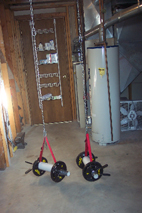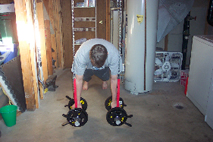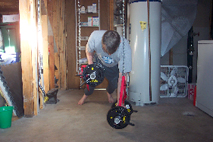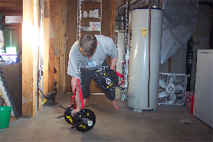
The Renegade Row is an incredible exercise for the upper body and core. Although I am not sure who originally thought of this exercise, Coach John Davies introduced it to a lot of us. To perform this exercise, assume a push-up position while holding a kettlebell or dumbbell in each hand. The KBs or DBs should be approximately shoulder width apart. Maintain good push-up position throughout (keep your body straight and rigid from the shoulders to the feet without arching your back or allowing your rear to lift up too high). Push one KB into the floor and pull the other KB up to your shoulder. Attempt to keep your hips parallel to the ground (do not allow the hip on the working side to rise higher than the one on the on the supporting side). Lower the KB to the floor and then repeat with the opposite arm. 



When I initially performed this exercise, I was pleasantly surprised how it worked the core and the chest. The core muscles are essential for stabilizing the body in order to row the KB from this position. This exercise works your chest because you need to push down hard on the KB to help stabilize your body and to keep the KB from tipping over.
I have realized the benefits of training with gymnastic-type rings for many years. Simple body weight exercises like push-ups and dips become different animals when done on the rings because of their instability. You need to utilize considerable body tension in order to stabilize the rings. I enjoy training with rings or other objects suspended from something above because they move independently of each other in any direction, and the movements that you can do are only limited by your imagination. I thought that Renegade Rows performed on handles suspended from my rafters would be an incredible exercise, and I was not disappointed when I tried it.
For handles, I used two 10-inch long sections of 3-inch PVC pipe that were suspended from the rafters with chain. I selected the 3-inch PVC to challenge the grip in addition to the upper body and core muscles. I then placed a 20-inch long section of 1-1/2-inch PVC pipe through each of the 3-inch PVC pipes so that it extended beyond the 3-inch PVC on either side to add weight. Place Olympic plates on either side of the 1-1/2-inch pipes. Slide the plates snug up against the 3-inch PVC pipes and then secure the plates in place with a spring collar. I did need to add a little duct tape on the ends of the 1-1/2-inch PVC pipe so that the spring collars would not slip.
Prior to performing Suspended Renegade Rows, I recommend that you experiment with push-ups and shifting your weight from one arm to the other. Once you get comfortable with stabilizing the rings in the push-up position, do progressively heavier Suspended Renegade Rows until you find the weight that is challenging for you. There are many ways to vary the difficulty of Suspended Renegade Rows:
• vary the size of the PVC pipe (the thicker PVC pipe will provide a greater grip challenge
• vary the amount of weight used
• vary foot position (begin with feet spread apart and gradually bring them closer together to increase the difficulty)
Enjoy!














